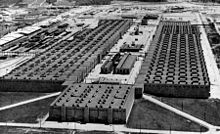K-25
The K-25 building was located in the Oak Ridge National Laboratory near Oak Ridge in Tennessee until its demolition (2010–2012) and was one of the most important facilities for uranium enrichment in the Manhattan Project . For this purpose, huge facilities were housed inside, which produced enriched uranium for the first atomic bombs by means of gas diffusion . Since this type of uranium enrichment is very energy-intensive, K-25 was one of the largest electricity consumers in the USA when it was commissioned. In 1954, Oak Ridge alone consumed 10 percent of the electrical energy available in the United States.
Establishment
Construction began in June 1943 and was completed in the spring of 1945. At the time, the K-25 was the largest building in the world and, at a cost of $ 512 million, the most expensive facility in the Manhattan Project. The construction was so complex that a large number of construction companies had to work on it at the same time. It was roughly shaped like a capital U, over 800 meters long and 300 meters wide. This made it much larger in area than the Pentagon, for example . Another example of the time pressure under which the entire Manhattan project was under was that construction of the K-25 had already begun, although the gas diffusion process had not yet been fully developed.
business
Around 25,000 people worked in the building from 1944. Most of them without knowing what. In order to be able to accommodate the many workers, the Army built the town of Happy Valley in 1943 in the immediate vicinity, where around 15,000 people last lived in caravans.
Enrichment of 235 U began towards the end of 1944. Most of the uranium used in the Hiroshima Little Boy bomb was processed into K-25.
Production continued after the Second World War . Gas diffusion was the only isotope separation process that was used on an industrial scale during the Cold War. In the course of this, similar systems were built in various other locations in the USA, which were built on the model of Oak Ridge.
Cessation of production
Since the 1960s and finally in 1987, the production of weapons-grade material in K-25 was stopped. Since then, the building has been falling into disrepair. The entire facility was radioactively contaminated and could not be entered without permission.
demolition
In 2008, the United States Department of Energy decided to demolish the facility. The dilapidation of the buildings, erected in a hurry in the 1940s and neglected since the 1980s, had reached a level that would soon have endangered the safety of the demolition workers beyond measure (e.g. sagging roofs, unsafe floors, cracks in Columns). The western, less dilapidated and less radioactive part of the building was first demolished in order to gain experience for the demolition of the east wing. According to the first schedule, the contracted company Bechtel Jacobs should have completed the necessary demolition work by the end of 2011. However, there were delays, so that the extensive demolition of the two long wings could only be reported in September 2012, except for a section of the east wing, which is still contaminated with the long-lived isotope 99 technetium and therefore has to be decontaminated first. The work was completed in December 2013.
As early as April 2010 it became known that efforts to preserve at least the northern part of the building, which forms the lower part of the "U", for posterity had failed. According to the Ministry of Energy, its structure is too attacked to be restored at a reasonable cost and has to be torn down. At the moment, the aim is to build an “interpretive center” and merely maintain a “security portal” for the system. Instead, it was decided in 2013 that a three-story building would be built to display some of the original equipment from the factory. It will convey the dimensions of the K-25 facility.
See also
Web links
- Photo gallery of some US nuclear production plants from World War II, including K-25 (English, inserted on April 19, 2010, changed on April 2, 2017)
Individual evidence
- ↑ K-25 demolition begins ( Memento from April 18, 2009 in the Internet Archive ) (accessed April 19, 2010)
- ↑ Contractor completes K-25 East Wing Demolition and moves to North End (Eng., Added Sep. 22, 2012)
- ↑ a b Department of Energy: Energy Department Completes K-25 Gaseous Diffusion Building Demolition , December 19, 2013
- ↑ Blog post from April 2010 about conservation efforts, with an overview picture of the system from September 2009 (English, inserted April 19, 2010, last checked November 20, 2014)
Coordinates: 35 ° 56 '9 " N , 84 ° 23' 38" W.
